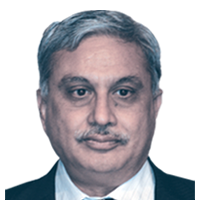
|
KeynoteDr Shailesh Nayak
Distinguished Scientist
Ministry of Earth Sciences
India
BiographyDr. Shailesh Nayak currently is 'Distinguished Scientist' in the Ministry of Earth Sciences and President, International Geological Congress. He obtained PhD degree in Geology from the M.S University of Baroda in 1980. He was the Secretary, Ministry of Earth Sciences, Government of India, during August 2008-2015, and provided leadership for programs related to earth system sciences. He has been credited with launching many research programs related to monsoon, air-sea interaction, changing water cycle, atmospheric chemistry, coastal vulnerability, climate services, polar science, etc. with US, UK, Germany, Japan, Australia, Norway, South Korea. He had set up HPC system having 1.1 Peta flops capacity for weather and climate research and operations. He had restructured meteorological activities in the country and thus improved weather and hazard related services.
He had set up the state-of-the-art tsunami warning system for the Indian Ocean in 2007 in just two years time, and providing tsunami advisories to the Indian Ocean rim countries. He pioneered in development of algorithms and methodologies for application of remote sensing to coastal and marine environment, and generated baseline database of the Indian coast, and developed services for fishery and ocean state forecast.
He is Fellow of the Indian Academy of Sciences, Bengaluru and the National Academy of Sciences, India, Allahabad. He has been awarded Honorary Degree of Doctor of Science by the Andhra University in 2011, Assam University in 2013 and Amity University in 2015. He was conferred the prestigious ISC Vikram Sarabhai Memorial Award 2012 as well as Bhaskara Award for 2009, Fellowship of the International Society of Photogrammetry & Remote Sensing (ISPRS) and Academician of the International Academy of Astronautics (IAA) for his outstanding contributions in remote sensing and GIS. He has published about 150 papers in peer-reviewed journals. Abstract Mitigating Tsunami Risk in the Indian OceanA state-of-the-art tsunami warning system set up in October 2007 is a classic case of use of satellite-based communication and remote sensing, computing and GIS to mitigate risk from tsunami in the Indian Ocean. The system is capable receiving and analyzing seismic data for estimating earthquake parameters as well as tidal and sea levels, received from the Indian and global stations in real time. Model simulations based on earthquake parameters, are being used to generate advisories about travel time, run up height at 1800 coastal forecast points and are provided within 10 minutes to all concerned stakeholders of the Indian Ocean Rim countries, including India. Hence, it is also recognized as the Regional Tsunami Warning System by UNESCO/ IOC. This is the only system which takes care of both tsunamigenic zones, the Makran and the Sumatra subduction zones. The system has provided very useful advisories during last ten years to all countries in the Indian Ocean Region and has performed as per laid down standards.
The system is constantly being upgraded by carrying out research related to understanding of earthquake and tsunami generation processes. GPS and accelerometer network in the Andaman and Nicobar Islands have been installed to assess the size of rupture and link to magnitude for great earthquakes, so that underestimation of magnitude of such earthquakes can be avoided. Information about repeat cycles of tsunami events by locating paleo-tsunami deposits and dating them has been generated for the Indian coast.
Vulnerability maps generated using high-resolution satellite-derived topographic details and other oceanographic parameters provide information about number of villages and towns likely to be affected. Such maps have emerged as a major tool towards providing site-specific hazard and risk related products to enable appropriate planning of pre and post disaster management strategies.
The effective communication with local administrators, media as well as people at large is very critical. All possible mode of communication, electronic, print, mobile, web, etc. have been deployed.
An effective collaboration with Indonesia and Australia along with UNESCO-IOC to build observational systems and data standards and exchange, networking of required services and preparing human communities. Resources, in terms of financial, human or technological are required to sustain such services.
However, only building capacity to forecast and early warning is not sufficient to mitigate risk from the hazards. The existing social systems, political, economic and industrial structures are equally important to provide resilience to society. An ability of local administration to respond to such a event and effective communication to people at large is very critical. An education system that produce scientists and managers needed to implement such a approach, at a regional, national, institutional and individual level is the need of the hour.
|
